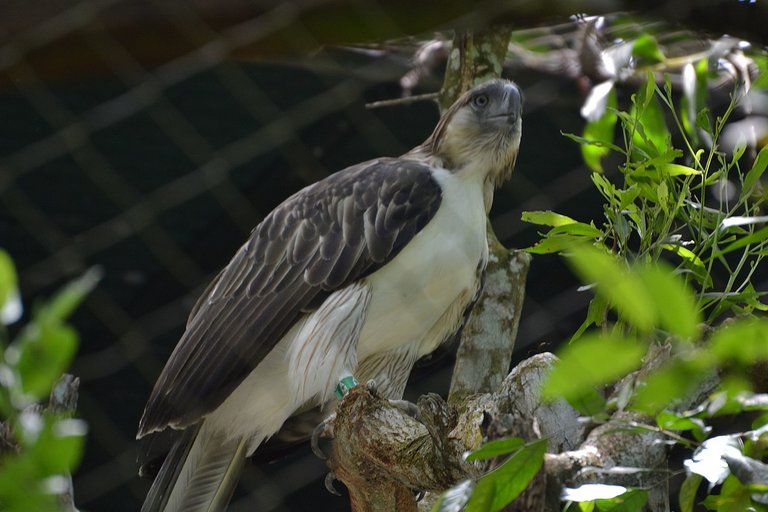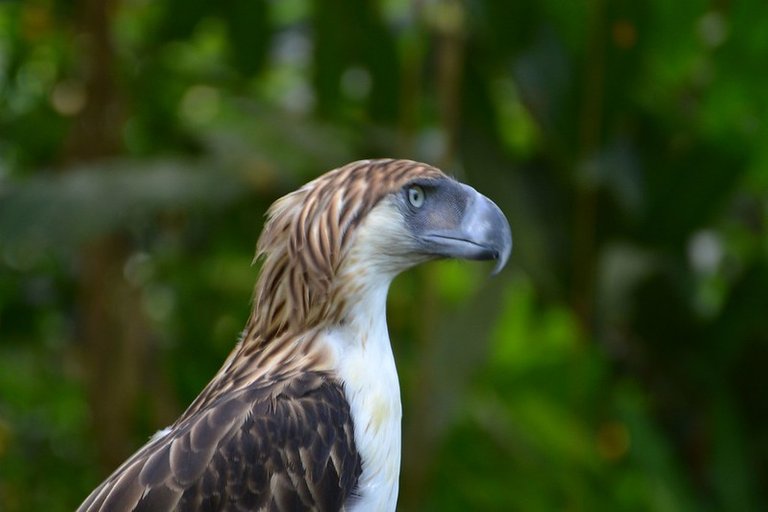Philippine Eagle: The king is in trouble.

With a body length of almost 3.3 feet, the Philippine eagle (Pithecophaga jefferyi) is the world's largest eagle species. It can weigh up to 18 pounds, has a 6.5-foot wingspan, and as many as 1,900 pairs formerly colonized practically every island in the archipelago in 1910. The current count is as low as 400 adult pairs due to decades of habitat loss due to mono-crop plantations, logging, resource extraction such as mining, an exploding human population, and increasingly destructive weather patterns brought on by climate change. Some conservationists believe the number is far lower, estimating that only 200 individual birds survive.
Locals dubbed the Philippine eagle as the monkey-eating eagle. It feeds flying squirrels and lemurs, civets and rats, reptiles, and birds. We can spot it on the edges of forests, and even in previously logged areas, it prefers to hunt, nest, and rear its young inside the forest. Philippine eagles live a longer life. Scientists say it is vital that young birds have enough room to leave their parents and generate their offspring without harm.
To effectively nurture a single Philippine eagle, it requires 133 square kilometers. Although the species can be found as low as sea level, we can see several of its lowland habitat destroyed, restricting it to mountain slopes, particularly in remnant dipterocarp forests. The Philippine eagle's existence has become instinctive due to our continued conversion of its natural habitat. It is one of the primary threats to the population of Philippine eagles.

Natives used monkey flesh to trap and kill the bird, which used to prey on their livestock. Because of its fondness for monkey meat, the bird earned the moniker "monkey eating eagle. Photo Credit: Shankar S.
Despite its status as the national bird and as the crowned kingbird of the locals, the Philippine eagle has a contentious relationship with humans. As a result of poaching and deforestation, eagles have become critically endangered. We can found the Philippine eagles can be four of over 7,000 islands of the Philippines, namely Luzon, Samar, Leyte, and Mindanao. It is mostly on forests in the lowlands and at mid-elevation. Most areas in lowlands and mid-elevation are for construction and logging. It sends many eagles farther into the mountains, which is not their favored habitat.
The widespread deforestation caused the Philippine eagle to become a critically endangered species due to the loss of its native habitat due to forest loss. In 1934, about 57 percent of the Philippines' total geographical area was a forest. It decreased to 6.1 million hectares by 1990. Only over 800,000 hectares remain to date. Again, the cause was deforestation, shifting cultivation, forest fires, and conversion to agricultural fields and human settlements. Around 20 million people live in upland areas, which contain the majority of the woods.
The Philippines has lost about 75% of its forests since the turn of the century. The deforestation of tropical hardwood trees caused a loss of nest for these eagles. The International Union for Conservation of Nature (IUCN) has classed them as severely endangered, with only 400 pairs remaining in the wild. The Philippine eagle prefers to live in the forest, especially in densely forested areas. The logging and reckless resource usage are destroying the woods, and hence the species' habitat. Deforestation is one of the causes of Philippine eagle mortality.

The Philippine Eagle (Pithecophaga jefferyi), has brown and white plumage and a shaggy crest. It reaches 2.82 to 3.35 feet long and weighs 4.7 to 8.0 kilos. Photo Credit: Shankar S.
The Philippine Eagle is not only one of the world's largest eagles, but it's also one of the most visually appealing. It has a jet black bill with a blue tinge, neon yellow feet, and mild gray-blue eyes. The fringe-like feathers on its legs mirror the long brown feathers, which over its head and the back of its neck, and its cottony white belly contrasts with its darker back. Philippine Eagles are diurnal, meaning they hunt, fly, build nests, engage in courtship activities, and conduct other activities throughout the day. They sleep during the night. These eagles are swift in the air despite their size, which helps them be successful hunters.
Philippine eagles excel at hiding, making them hard to study. The eagles are visible during the mating season when the eagles conduct particular cries and flight displays. It even clasps claws in mid-air, though not in the same thrill-seeking fashion as bald eagles, who lock talons and drop in a deadly spiral into the ground before releasing each other as their favorite form of foreplay. Before mating, male Philippine eagles provide their females with food and nesting supplies to clinch the bargain. They have lifelong monogamous relationships and reproduce using the same courtship display.
Female eagles deposit one egg every two years, which incubate for nearly two months with the help of their husbands. When eggs are hatch, the male eagle does most of the hunting while the mother feeds the eaglets. Macaques, palm civets, flying squirrels, bats, birds, snakes, and other reptiles are among the creatures eaten by Philippine eagles. Flying lemurs appear to be a favorite of Philippine eagles. Until they are roughly a year and a half old, children live with their parents. They then go off on their own for the following four years, traveling from forest to forest and over open fields until they achieve sexual maturity, at which point they find a mate and a spot to call home.

Locals dubbed the Philippine eagles as "Haring-ibon" (King of Birds). Photo Credit: Gerhard Bögner
Philippine Eagles, like all top predators, play a critical role in their surroundings. We referred to it as an umbrella species, which preserve by protecting a single species. It is similar to how we can protect others from the rain using one enormous umbrella. We must protect the monkeys, civets, and other animals that they eat, as well as the plants and animals that the monkeys and civets eat. With that, we can protect the eagles too. We must also protect the trees that the Philippine Eagles nest. When we preserve the Philippine eagles and their habitat, we can protect the other plants and animals that call the area home.
The Philippine eagle is a symbol of national pride. As a result, we must protect and prevent it from going extinct. As we have seen, forests disappear, rivers dry up, floods and droughts spark wildfires, and hundreds of our forest pals die. Men depart the area because it is no longer productive. We saw the gradual disintegration of our environment. I am convinced that if this onslaught continues, all life will suffer and die. We should work together to maintain and preserve these species so that future generations can see them and appreciate them. Let us not be self-centered.
Readings
Brad, Miller, Critically endangered Philippine eagle hangs on despite horde of threats
Jennifer Lu, Watch an endangered eagle chick grow up in rare video
Ronica Valdeavilla, Philippine Eagle: 11 Facts About The Philippines' National Bird
Henrylito Tacio, Philippine Eagles Facing Extinction, Deforestation Main Cause
Tammy Danan, How the Philippine Eagle is Reclaiming its Habitat and Saving the Forest
Paul Gabrielsen, What factors put Philippine birds at risk of extinction?
Glen Lovell Bueser, et. al., Distribution and nesting density of the Philippine Eagle Pithecophaga jefferyi on Mindanao Island, Philippines: What do we know after 1OO years?
Note: The eagle image in the cover photo is from Wikimedia Commons.
I went trekking at Mount Apo back in 2007. The guide assured me I'd get to see one and........not a chance lol!
Unfortunately, eagles are now very stealthy in the wild. It is a sad fate for our king of the birds.
Dear @juecoree, Philipines eagle is wonderful! I hope such wonderful animals prosper! 😄
Hopefully, they can continue to populate in captivity and in wild. Unfortunately, their population is quite small.
As of the moment I can only hope that the the Philippine Eagle endures so that future generations will see them.
I do hope too that it will endure.
Congratulations @juecoree! You have completed the following achievement on the Hive blockchain and have been rewarded with new badge(s) :
Your next target is to reach 2000 comments.
You can view your badges on your board and compare yourself to others in the Ranking
If you no longer want to receive notifications, reply to this comment with the word
STOPThanks for your contribution to the STEMsocial community. Feel free to join us on discord to get to know the rest of us!
Please consider supporting our funding proposal, approving our witness (@stem.witness) or delegating to the @stemsocial account (for some ROI).
Please consider using the STEMsocial app app and including @stemsocial as a beneficiary to get a stronger support.